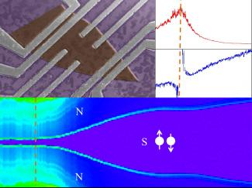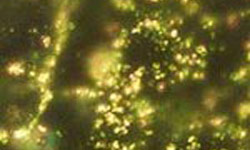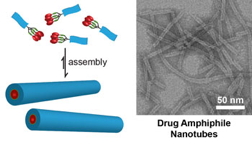Science
W3 star-forming region

The full image of the W3 region. Click on the image to see an annotated version, highlighting some of the key features.
- Read more
- 362 reads
Interdisciplinary team demonstrates superconducting qualities of topological insulators: Findings may prove useful in search for elusive Majorana quasiparticle

Top left: SEM image of a typical device. Mechanically exfoliated Bi2Se3 thin film is colored as brown and contact metals consist of Ti(2.5nm)/Al(140nm). Top right: Hall data where red curve is longitudinal resistivity and blue curve is Hall carrier density as a function of gate voltage. Bottom figure: 2D plot of differential resistance as a function of gate voltage(x axis) and current(y axis). Purple region in the center corresponds to zero differential resistance (superconducting regime)
- Read more
- 348 reads
Deep Space Applauds NASA Asteroid Initiative - Calls for Collaboration with Private Sector

- Read more
- 384 reads
Suzaku 'Post-mortem' Yields Insight into Kepler's Supernova

This composite of images from NASA's Chandra X-ray Observatory shows the remnant of Kepler's supernova in low (red), intermediate (green) and high-energy (blue) X-rays. The background is an optical star field taken from the Digitized Sky Survey. The distance to the object is uncertain, with estimates ranging from 13,000 to 23,000 light-years, but recent studies favor the maximum range. This image spans 12 arcminutes or about 80 light-years at the greatest distance.
- Read more
- 315 reads
Hubble Breaks Record in Search for Farthest Supernova

This is a Hubble Space Telescope view of supernova SN UDS10Wil, nicknamed SN Wilson that exploded over 10 billion years ago. The small box in the top image pinpoints SN Wilson's host galaxy in the CANDELS survey. The image is a blend of visible and near-infrared light. The three bottom images, taken in near-infrared light demonstrate how the astronomers found the supernova. The image at far left shows the host galaxy without SN Wilson. The middle image, taken a year earlier, reveals the galaxy with SN Wilson. The supernova cannot be seen because it is too close to the center of its host galaxy. To detect the supernova, astronomers subtracted the left image from the middle image to see the light from SN Wilson, shown in the image at far right.
- Read more
- 354 reads
NASA Flies Radar South on Wide-Ranging Expedition

On March 17, 2013, NASA's Uninhabited Aerial Vehicle Synthetic Aperture Radar (UAVSAR) acquired synthetic aperture radar data over the Napo River in Ecuador and Peru. The image colors indicate the likelihood of inundation (flooding) beneath the forest canopy, which is difficult to determine using traditional optical sensors.
- Read more
- 332 reads
Iranian Researchers Produce Gold Nanoparticles from Fungus

- Read more
- 378 reads
Mapping the Chemistry Needed for Life at Europa

This color composite view combines violet, green, and infrared images of Jupiter's intriguing moon, Europa, for a view of the moon in natural color (left) and in enhanced color designed to bring out subtle color differences in the surface (right). The bright white and bluish part of Europa's surface is composed mostly of water ice, with very few non-ice materials. In contrast, the brownish mottled regions on the right side of the image may be covered by hydrated salts and an unknown red component. The yellowish mottled terrain on the left side of the image is caused by some other unknown component. Long, dark lines are fractures in the crust, some of which are more than 3,000 kilometers (1,850 miles) long.
- Read more
- 404 reads
Scientist Studies How to Turn Cancer Drugs Into Their Own Delivery Systems:Key is incorporating water properties into effective nanoscale systems

(Left) Schematic illustration of the design concept for self-assembling drug amphiphiles. The drug loading within the self-assembled nanostructures is defined by the nature of molecular design. (Right) TEM image of nanotubes formed by self-assembly of a drug amphiphile containing four camptothecin drugs. These nanotubes possess a fixed drug loading of 38% (w/w).
- Read more
- 375 reads
Human Rights
Fostering a More Humane World: The 28th Eurasian Economic Summi

Conscience, Hope, and Action: Keys to Global Peace and Sustainability

Ringing FOWPAL’s Peace Bell for the World:Nobel Peace Prize Laureates’ Visions and Actions

Protecting the World’s Cultural Diversity for a Sustainable Future

Puppet Show I International Friendship Day 2020


